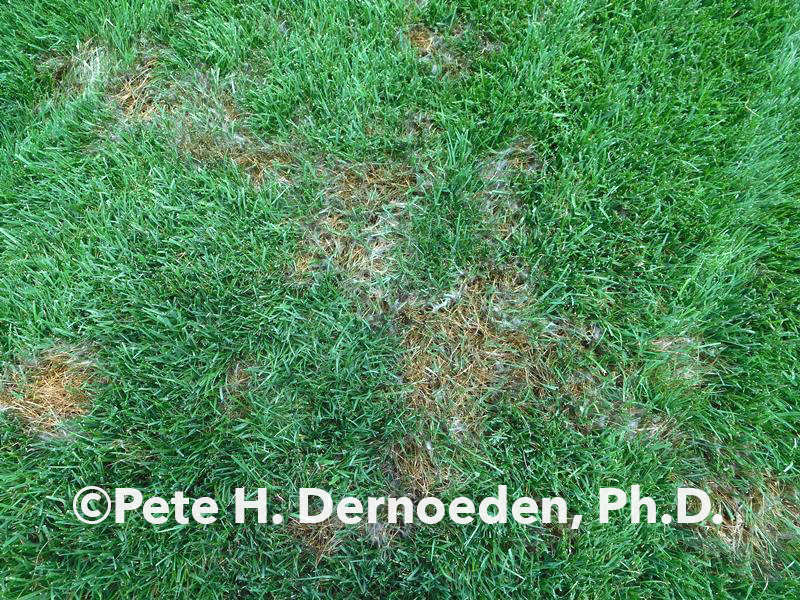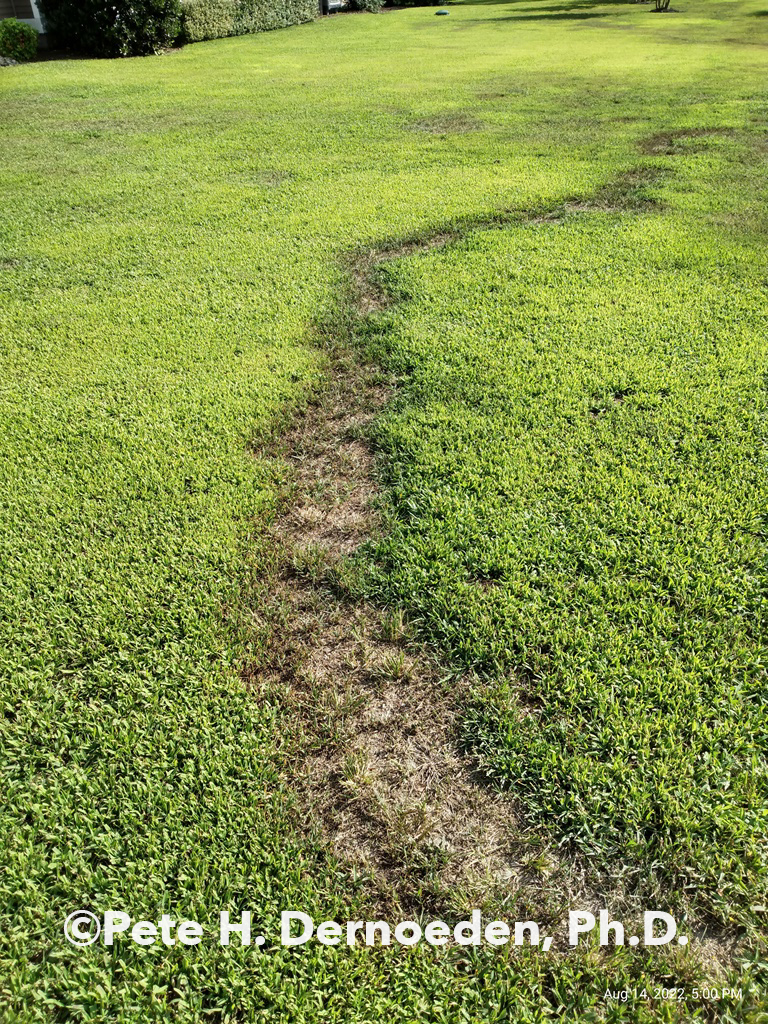
Pete H. Dernoeden, Ph.D. Professor Emeritus, University of Maryland

Summer in the mid-Atlantic is weather-challenging and has the potential of damaging/killing large areas of turf. Lawns seemed to take a bigger hit in 2022 than golf courses and sod farms, but there were exceptions. The latter 2 weeks of July were marked by intense heat (most days 90°F+, intense humidity, little wind movement). Greatest damage coincided with thunderstorm activity on or about the 21-27 July time period. Some areas experienced thunderstorm deluges of > 2.0” , which was followed in a few days with a series of thunderstorms delivering 0.5 -2.0” of more. The most devastating thunderstorms occurred during day time hours, when significant amounts of rain-thunderstorm-overcast weather quickly were followed by a return of intense sunlight, heat and stifling humidity levels. The later scenario can result in wet wilt or scald; which mostly occurs in golf course turfs, and especially greens.
Heat, high humidity and thunderstorm activity also brought on intense levels of diseases (esp. Pythium blight, brown patch and summer patch).The rains coincided with the breakdown of the residual effectiveness of spring applied pre-emergence herbicides, thus resulting in the appearance of massive levels or crabgrass, and goosegrass, as well as the sudden appearance of spurges, yellow nutsedge, Kyllinga and many other pernicious weeds.
Wet-wilt occurs during hot and humid periods when thatch and soils are waterlogged. Water in or on the surface of thatch or mat absorbs heat from the sun. Heat in water is transferred to the soil and stored. This is why the upper one to two inches of soil can have temperatures exceeding 95°F on sunny days, when ambient temperatures are about 90°F. Due to a combination of heat stress from high air and soil temperatures, low soil oxygen levels, and stomatal closure [stomates are small pores on both leaf surfaces that are essential to plant health], and roots are unable to absorb water. Turf grown on greens, tees, fairways and even in roughs can be killed in just a few hours. On affected greens, turf initially appears wilted-grayish, then brownish and water soaked, and turf thins-out in irregular patterns. It may take up to 3 days to see the maximum deadly effect of wet wilt. Damage often is more severe in surface water drainage patterns. The combination of heat stress, waterlogged soils (and poor gas exchange) and mechanical injury from mowing causes leaves to collapse. In some instances, the turf almost literally “cooks and suffocates” in hot and wet soils. The negative impacts of hot and wet soils on golf greens may take a few days to become totally apparent; but by early August, everyone knew whether they suffered or survived. By the second week of August, temperatures moderated into the 80’s°F highs and breezy conditions, which provided a brief respite for turf managers.


Wet wilt damage; green areas were dyed to mask turf loss.


Wet wilt initially appears as a brownish water soaking of turf. Wet wilt injury often is more severe in surface water drainage.
Wet Wilt Management: Increase mowing height to ≥ 0.135”; skip mowing every 2 to 3 days; use light weight walk-behind mowers; use solid not grooved rollers; solid-tine or spike greens to below the thatch-mat depth weekly [if there is any lifting of the sod-stop immediately]; spoonfeed by spraying about 0.125 lb N/1000 sq. ft. using urea every 7-10 days: keep turf alive during the day by syringing {keep nozzle horizontal and apply a light film of water to canopy; should take only 3-5 minutes to syringe an average sized green} in a Dr. Pepper Timing (i.e. 10AM; and 2 and 4 PM); and avoid any mechanical damage from equipment on putting surfaces.
You Make The Call: To be different, I’m going to show a series of photos and will allow you to diagnose the problem. Most are common diseases that were prevalent this summer. It’s on the “Honor System” and I encourage you to block the photo captions with stiff card. The winner gets an evening with Mr. Mark Merrick, CGCS at The Green Onion to enjoy all the National “Natty” Boh’s, pickled eggs and onions, and peanuts you can consume.

Grayish-white Pythium mycelium in tall fescue.

Orange-bronze colored spots of Pythium bight in tall fescue sod.

Pythium blight in a water drainage pattern in shaded tall fescue; turf will need repair.

Brown patch with black algae in a bentgrass golf green.

Circular patches with Rhizoctonia brown patch mycelium in tall fescue.

Classic chocolate-brown leaf lesions in tall fescue infected by Rhizoctonia brown patch.

Numerous circular Rhizoctonia brown patches in an immature stand of tall fescue.

Nitrogen from a fairy ring darkens turf, improves density and helps exclude weeds.

A unique fairy ring shows drought dormant tall fescue surrounded by light green crabgrass. Aug., 2022.

Summer patch is a root pathogen that selectively kills annual blue in bent greens. Fresh infection in Poa appear bronzed.
._Large_depressed_summer_patch_in_a_susceptible_vs._resistant_Kentucky_bluerass_cultivar_(1)_copy.jpg)
Initial summer patch infection appear as small spots (right). Left shows depressed summer patch in a susceptible vs. resistant Kentucky bluerass cultivar.

Summer patch in a Kentucky bluegrass green surround. Courtesy of S. McDonald.

Summer patch typically appears as depressed crater pits in lawns with a yellowish bronze periphery.

Summer patch selectively killing Ky. bluegrass in a mixed tall fescue lawn.

_copy.jpg)
Extreme mechanical damage caused by mowing a drought-stressed lawn.
 Dr. Pete's Turf Tips
Dr. Pete's Turf Tips